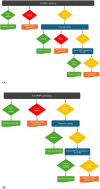Does use of anal cytology as a triage test improve the performance of high-risk human papillomavirus screening in gay and bisexual men for anal cancer prevention?
- PMID: 39279187
- PMCID: PMC11621999
- DOI: 10.1002/ijc.35185
Does use of anal cytology as a triage test improve the performance of high-risk human papillomavirus screening in gay and bisexual men for anal cancer prevention?
Abstract
Anal high-risk human papillomavirus (HRHPV) testing-based anal cancer screening gay and bisexual men (GBM) is associated with high sensitivity, but low specificity. We report the potential role of triage use of anal cytology with HRHPV testing in detecting 12-month persistent anal high-grade squamous epithelial lesions (HSIL) in a cohort of GBM in Sydney, Australia. Participants were GBM from the Study of the Prevention of Anal Cancer (SPANC) who underwent annual anal HPV testing, cytology, and high-resolution anoscopy (HRA)-guided histology. The sensitivity and specificity of five screening algorithms based on HRHPV test results with triage use of anal cytology (atypical squamous cells of undetermined significance (ASCUS) and atypical squamous cells, cannot exclude HSIL (ASC-H) used as referral thresholds) were compared to these of HRHPV testing and anal cytology alone. A total of 475 men who had valid HRHPV, cytological, and histological results at both baseline and first annual follow-up visits were included, median age 49 years (inter-quartile range: 43-56) and 173 (36.4%) GBM with human immunodeficiency virus. Of all triage algorithms assessed, two had comparable sensitivity with HRHPV testing alone in detecting persistent anal HSIL, but ~20% higher specificity and 20% lower HRA referral rates. These two algorithms involved the immediate referral of those with HPV16 and for those with non-16 HRHPV either immediate or delayed (for 12 months) referral, depending on cytology result at baseline. Triage use of anal cytology in GBM testing positive for anal HRHPV increases specificity and reduces referral rates while maintaining high sensitivity in detection of HSIL.
Keywords: anal cancer; cancer screening; homosexuality; human papillomavirus; male; screening performance.
© 2024 The Author(s). International Journal of Cancer published by John Wiley & Sons Ltd on behalf of UICC.
Conflict of interest statement
AEG has received honoraria and research funding from CSL Biotherapies and honoraria and travel funding from Merck. RJH has received honoraria and travel funding from CSL Biotherapies, and Merck. CKF owns shares in CSL. He has received support from CSL Biotherapies and MSD. SMG is the President of the International Papillomavirus Society, a consultant to Merck on HPV vaccines, and Working Group Member for HPV to SAGE, WHO. All other authors declare that they have no conflicts of interest.
Figures
References
-
- de Martel C, Georges D, Bray F, Ferlay J, Clifford GM. Global burden of cancer attributable to infections in 2018: a worldwide incidence analysis. Lancet Glob Health. 2020;8(2):e180‐e190. - PubMed
-
- Hillman RJ, Garland SM, Gunathilake MP, et al. Human papillomavirus (HPV) genotypes in an Australian sample of anal cancers. Int J Cancer. 2014;135(4):996‐1001. - PubMed
MeSH terms
Grants and funding
LinkOut - more resources
Full Text Sources
Medical
Miscellaneous


